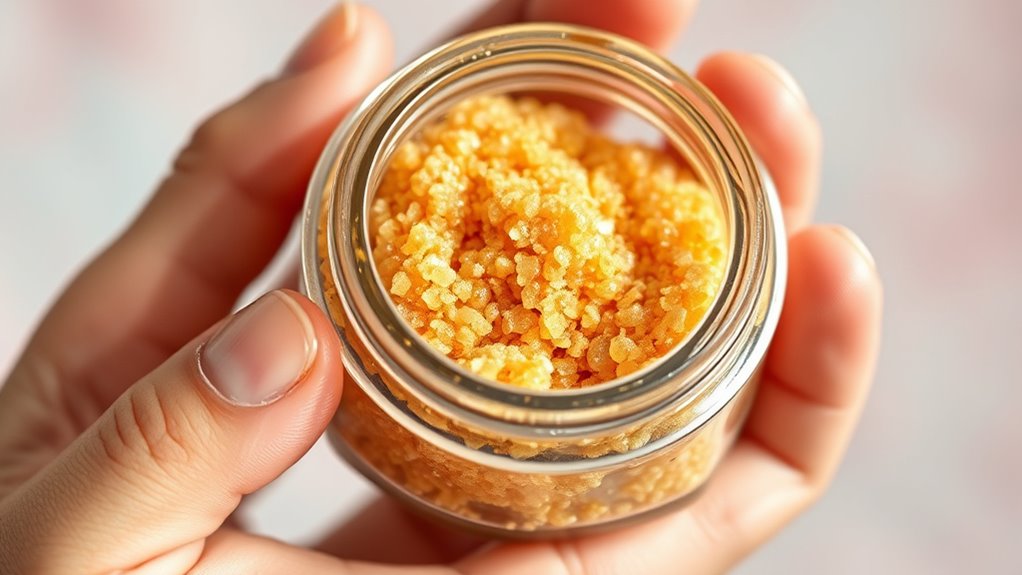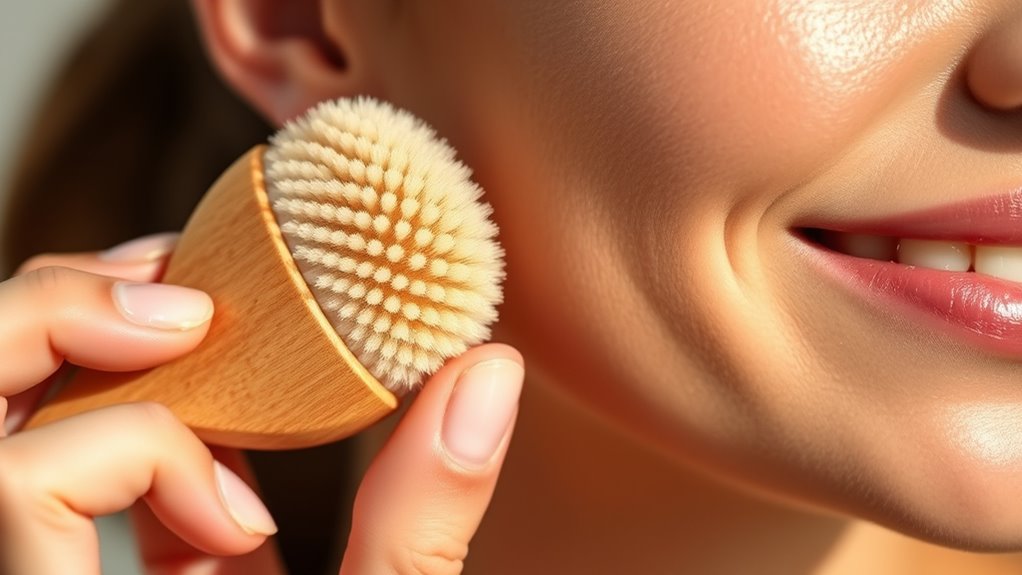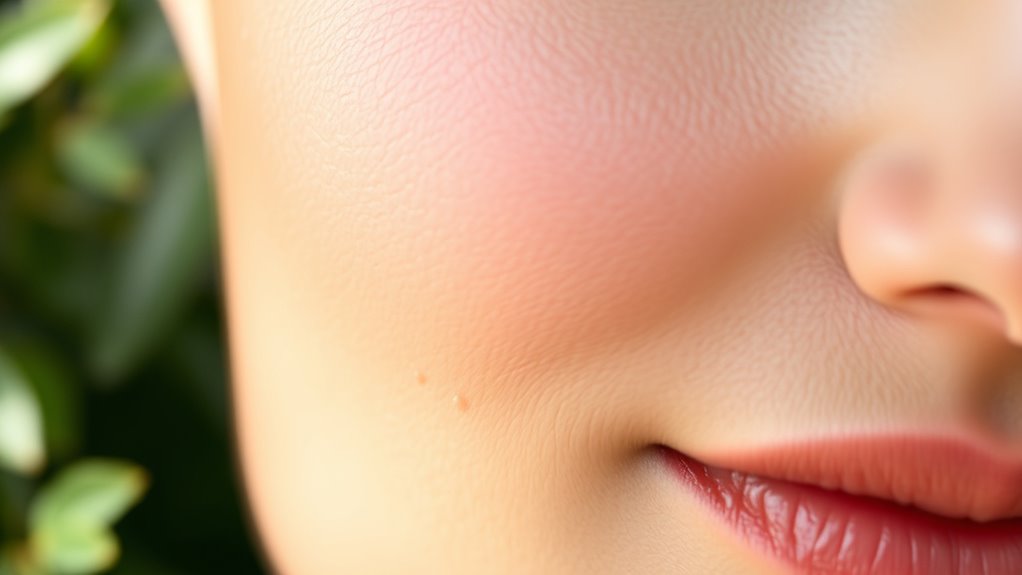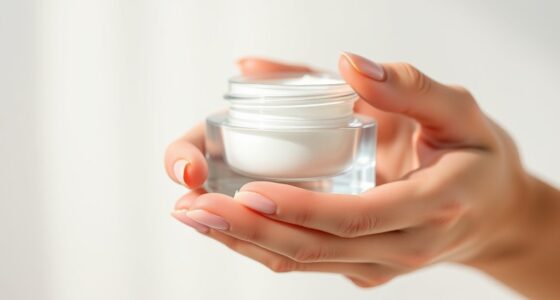To transform your skin texture, start by identifying your skin type and tailoring your exfoliation routine accordingly. For sensitive or dry skin, exfoliate once a week with gentle products; oily or acne-prone skin benefits from 2-3 times weekly. Always monitor how your skin responds, and avoid overdoing it. Consistent, gentle exfoliation improves smoothness and brightness over time—keep going, and you’ll discover even more about creating a routine that works for you.
Key Takeaways
- Customize exfoliation frequency based on your skin type: 1-3 times weekly for best results.
- Use gentle chemical exfoliants tailored to your skin’s sensitivity and needs.
- Incorporate exfoliation into your routine after cleansing and before moisturizing for optimal benefits.
- Monitor your skin’s response; reduce frequency if irritation or redness occurs.
- Consistently follow a personalized schedule to achieve smoother, clearer, and more even skin texture over time.
Understanding Your Skin Type and Exfoliation Needs

Understanding your skin type is essential for determining how often you should exfoliate. Knowing whether your skin is oily, dry, sensitive, or normal helps you choose the right frequency to avoid irritation or dryness. If your skin is oily, you might benefit from more frequent exfoliation to control excess sebum and prevent breakouts. Dry or sensitive skin, on the other hand, requires gentler and less frequent exfoliation to avoid stripping away essential moisture. Normal skin can usually handle a moderate approach. Pay attention to how your skin reacts—if it feels tight, red, or irritated, scale back. Recognizing your skin’s unique needs allows you to create a tailored exfoliation routine that promotes healthy, balanced skin without damaging it. Incorporating products with glycolic acid, such as glycolic acid serums or pads, can help improve skin texture and radiance when used appropriately for your skin type. Additionally, understanding exfoliation frequency is key to preventing over-exfoliation and maintaining skin’s natural barrier. Being mindful of skincare ingredients that suit your skin type further enhances your exfoliation routine and overall skin health. Exploring customized skincare routines and staying updated with AI-driven skincare innovations can also provide personalized recommendations tailored to your skin’s evolving needs.
Choosing the Right Exfoliants for Your Routine

Selecting the right exfoliant is essential to effectively improving your skin’s texture without causing damage. You need to match your skin type and concerns with the appropriate product. Incorporating personalized skincare analysis can help you identify your unique skin needs more accurately. Additionally, understanding the latest breakthroughs in skincare technology can guide you toward more effective formulations tailored for your skin. For example, recognizing signs of skin sensitivity can help prevent adverse reactions and select gentler options. Here’s a quick guide:
| Skin Type | Suitable Exfoliant |
|---|---|
| Sensitive | Gentle enzymatic or mild chemical |
| Oily/Acne-prone | Salicylic acid or glycolic acid |
| Dry/Dehydrated | Lactic acid or enzyme-based |
Choose a product that suits your skin’s sensitivity and needs. For sensitive skin, opt for calming, non-abrasive formulas. If you have oily skin, look for exfoliants that help control oil and clear pores. Dry skin benefits from hydrating, mild acids that exfoliate without stripping moisture. Incorporating AI-powered analysis can help you better understand your skin’s unique needs and choose the most effective exfoliant.
Weekly Exfoliation Schedule Breakdown

How often you should exfoliate each week depends on your skin type, concerns, and the products you use. Generally, a balanced schedule keeps your skin smooth without irritation. Here’s a simple breakdown:
Frequency of exfoliation varies by skin type; listen to your skin to avoid irritation.
- Sensitive or dry skin: Exfoliate once a week to avoid over-drying or irritation. Using gentle, hydrating exfoliants can help maintain moisture levels and prevent irritation. Incorporating gentle exfoliation methods can further protect sensitive skin. Additionally, choosing safe and effective exfoliants minimizes the risk of adverse reactions.
- Normal or combination skin: Aim for 2-3 times weekly for ideal renewal.
- Oily or acne-prone skin: Exfoliate 3 times a week to help control excess oil and prevent breakouts.
- Regular exfoliation can also support skin health by removing dead skin cells and promoting a brighter complexion. Adjust based on your skin’s response. If you notice redness, tightness, or sensitivity, cut back. Consistency is key, but always listen to your skin’s signals to prevent damage. Incorporating advanced skincare technologies can further optimize your exfoliation routine and skin renewal process.
How to Incorporate Exfoliation Into Your Daily Skincare

While weekly exfoliation helps maintain healthy skin, incorporating it into your daily routine requires careful planning to avoid overdoing it. Start by choosing a gentle, chemical exfoliant suitable for daily use, like a mild AHA or BHA. Use it after cleansing and before applying moisturizer. Apply a thin layer, ensuring even coverage, and don’t scrub or rub aggressively. If you’re new to daily exfoliation, start with every other day and monitor your skin’s response. Consistency is key, but so is listening to your skin—if you notice redness or irritation, scale back. Always follow up with a good moisturizer and sunscreen during the day, as exfoliation can increase your skin’s sensitivity. Incorporating the right projector technology can further enhance your viewing experience at home. Additionally, choosing products with gentle ingredients can help prevent irritation during frequent use. Regularly assessing your skin’s reaction and adjusting your routine accordingly will ensure optimal results. Developing a personalized exfoliation schedule based on your skin type can help you avoid over-exfoliating and maintain a healthy balance. Over time, this routine can help smooth texture and brighten your complexion.
Monitoring Your Skin’s Response and Adjusting Frequency

Pay close attention to how your skin reacts after each exfoliation session, as this is the best indicator of whether you’re using the right frequency. If your skin feels irritated, red, or inflamed, you may be exfoliating too often. Conversely, if you notice little to no change, you might need to increase the frequency. To fine-tune your routine, consider these steps:
- Observe your skin’s texture and overall comfort after each session.
- Adjust exfoliation frequency based on signs of irritation or stagnation.
- Keep a skincare journal to track reactions and improvements over time.
- Remember that consistent use of glycolic acid can lead to noticeable improvements in skin texture and pore size over time.
- Additionally, incorporating soothing essential oils like lavender oil can help calm the skin and reduce potential irritation from exfoliation.
- When using exfoliating acids, ensure your device is compatible with your skincare tools, such as Bluetooth features, to optimize your routine and avoid potential compatibility issues.
- Regularly updating your routine based on your skin’s changing needs is essential, especially as skin can become more sensitive with age or environmental factors.
Common Mistakes to Avoid During Exfoliation

One common mistake to avoid during exfoliation is overdoing it, which can lead to irritation and damage your skin’s barrier. Too frequent or aggressive exfoliation strips away healthy skin cells and weakens your skin’s defenses. Always listen to your skin’s signals—redness, dryness, or sensitivity are signs you’re overdoing it. Using harsh scrubs or strong acids improperly can worsen these issues. It’s better to start slowly, perhaps once or twice a week, and observe how your skin reacts before increasing frequency. Additionally, avoid combining multiple exfoliating products at once, as this can intensify irritation. Remember, gentler is often more effective, and patience is key to achieving healthier, smoother skin without setbacks. Incorporating sound healing science principles into your skincare routine can also promote a more balanced and healing environment for your skin. Understanding skin barrier health helps prevent over-exfoliation and supports overall skin resilience. Paying attention to product formulation can help you choose gentler options that align with your skin’s needs. Recognizing skin sensitivity as a factor can guide you in selecting suitable exfoliation methods to avoid adverse reactions. Being mindful of exfoliation frequency can further help you maintain a healthy skin texture and prevent setbacks.
Long-Term Benefits of Consistent Exfoliation

Consistent exfoliation, when done correctly, offers significant long-term benefits for your skin. It helps maintain a smoother, more even complexion and reduces the appearance of fine lines over time. With regular exfoliation, you’ll notice your skin becoming healthier and more resilient. Here are the key benefits:
Consistent exfoliation improves skin texture, reduces fine lines, and boosts overall skin health over time.
- Improved skin texture and tone, making your skin look fresher and more radiant.
- Reduced pore size, which minimizes blackheads and breakouts.
- Enhanced absorption of skincare products, maximizing their effectiveness.
Frequently Asked Questions
Can I Combine Physical and Chemical Exfoliants Safely?
You can combine physical and chemical exfoliants, but do so carefully. Use them on different days or at different times to avoid irritation and over-exfoliation. For example, apply a chemical exfoliant during the week and use a gentle physical scrub once a week. Always listen to your skin’s response, start with lower frequencies, and patch-test new products to keep your skin healthy and avoid damage.
How Do I Tell if My Skin Is Over-Exfoliating?
Imagine your skin is a garden. If you over-exfoliate, it’s like overwatering—roots can drown, and plants become weak. Signs of over-exfoliating include increased redness, irritation, sensitivity, and peeling. Your skin may feel tight or uncomfortable, and breakouts might increase. To avoid this, listen to your skin’s signals and cut back if you notice these signs. Balance is key to keeping your skin healthy and vibrant.
Are There Specific Ingredients to Avoid During Exfoliation?
During exfoliation, steer clear of ingredients that can irritate your skin, like alcohol, fragrances, and harsh astringents. Avoid strong acids like high concentrations of glycolic or salicylic acid if your skin reacts badly. Also, skip abrasive scrubs with large particles that can cause micro-tears. Instead, choose gentle, soothing ingredients like aloe vera or chamomile, and always listen to your skin’s response to prevent over-exfoliating.
How Does Exfoliation Affect Sensitive or Acne-Prone Skin?
They say “a gentle hand wins the race,” and that’s true for sensitive or acne-prone skin. Exfoliation can help clear dead skin and prevent breakouts, but overdoing it irritates and aggravates your skin. Use mild exfoliants, like enzymes or salicylic acid, and limit to 1-2 times a week. Listen to your skin’s signals, and always follow up with soothing, hydrating products to keep your skin balanced.
When Should I Consult a Dermatologist About Exfoliation Concerns?
If you’re unsure about your exfoliation routine or notice persistent irritation, breakouts, or redness, you should definitely consult a dermatologist. Don’t wait until skin problems worsen; seek professional advice early. A dermatologist can recommend suitable products or procedures tailored to your skin type and concerns. Remember, professional guidance helps prevent damage and guarantees you’re exfoliating safely, especially if you have sensitive or acne-prone skin.
Conclusion
Ready to see your skin transform? Stick to your exfoliation schedule and pay close attention to how your skin reacts. The secret to flawless texture isn’t just in routine—it’s in consistency and knowing when to push or pause. Keep experimenting, stay patient, and watch as your skin reveals its true glow. The next step could be just around the corner—are you prepared to *uncover* the secrets that await?









